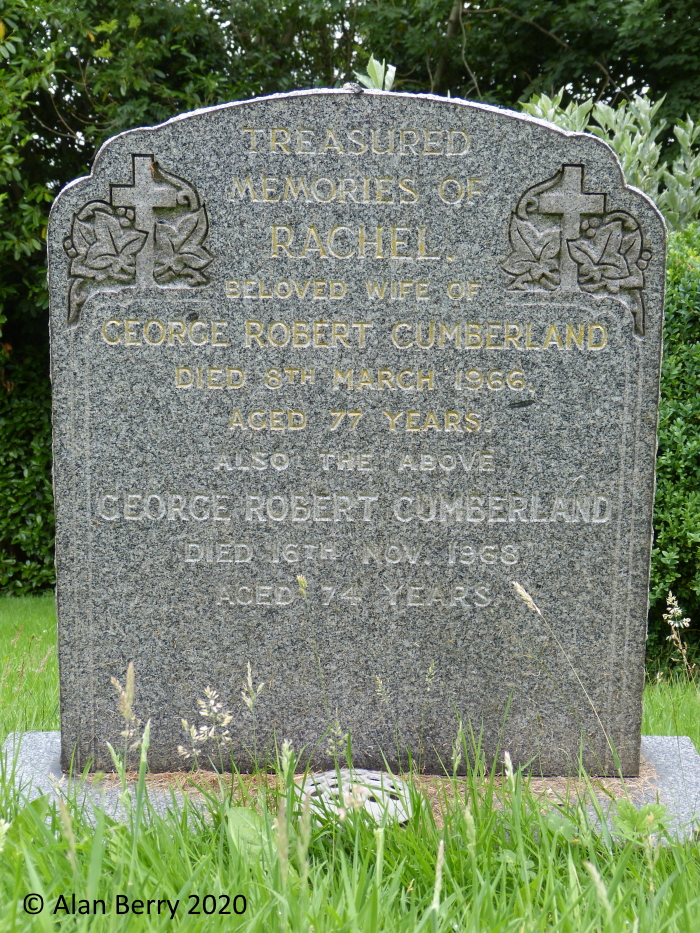THE VILLAGERS OF COLLINGHAM AND LINTON WHO SERVED IN WORLD WAR ONE
COLLINGHAMANDDISTRICTWARARCHIVE.INFO
 CONTACT
CONTACT




Rank Sergeant
Service Number 74044
Service Army
Battalion 29 Brigade
Regiment Royal Field Artillery
Buried St James on the Corner, Wetherby
Trade or Occupation pre-war: Farm lad
Marital status: Single
* Taken from attestation papers or 1911 census
** Marital status on enlistment or at start of war
- Named as an Absent Voter due to Naval or Military Service on the 1918 or 1919 Absent Voter list for Collingham, Linton or Micklethwaite
Biography
Family background
George Robert Cumberland was born on the 8th November 1894 in Tadcaster, the son of John R Cumberland and his wife, Sarah (nee Stubbs). In 1911, George was working, aged 15, as a lad at Park Farm, Hoyland, Tadcaster. He attested for service in The Royal Artillery before The Great War on the 19th Sept 1913 in Beverley.
Service record
We do not know much about George's military service during the war - we know that he was returned on the 1918 and 1919 Electoral Rolls of Micklethwaite as being Absent on account of Naval or Military Service. George's service record has not survived, but we believe that he served as Driver, then Sergeant 74044 George Robert Cumberland of the 29th Brigade of the Royal Field Artillery (RFA). George's medal card for the Great War shows he was awarded the British War Medal, the Victory Medal and the 1914 Star. The qualifying date for the last medal probably means that George was either already in the Army on the outbreak of war, or that he was a trained reservist who was immediately mobilised. Certainly George first went overseas on the 23rd August 1914 very soon after the outbreak of war.
Since George's service record has not survived we cannot be sure whether he left 29 Brigade Royal Field Artillery at any time in the war, but assuming he remained with this unit throughout the war we can gain a view of what events he may have taken part in.
29 Brigade RFA was part of 4th Division and George would have served in either 125 Battery, 126 Battery or 127 Battery RFA. 4th Division was a Regular Army Division (again perhaps hinting that George was a regular soldier before the war) and was stationed at Woolwich, Shornecliffe, Dover and Colchester prior to the outbreak of the war. The Division arrived in France in August 1914 and served in France and Flanders until the Armistice.
The 4th Division took part in the following battles:
1914
- Battle of Le Cateau. 26 Aug 1914.
- Affair of Nery. 1 Sep 1914.
- Battle of the Marne. 7-10 Sep 1914, including the passage of the Petit Morin and the passage of the Marne.
- Battle of the Aisne. 12-15 Sep 1914, including the capture of the Aisne Heights including the Chemin des Dames.
- Battle of Messines. 12 Oct-2 Nov 1914.
- Battle of Armentieres. 13 Oct-2 Nov 1914, including the capture of Metern.
1915
- Battle of St. Julien. 24 Apr-5 May 1915.
- Battle of Frezenberg. 8-13 May 1915.
- Battle of Bellewaarde. 24-25 May 1915.
1916
- Battle of Albert. 1-13 Jul 1916, including the capture of Montauban, Mametz, Fricourt, Contalmaison and La Boisselle.
- Battle of Le Transloy. 1-18 Oct 1916, including the capture of Eaucourt l'Abbaye, Le Sars and the attacks on Butte de Warlencourt.
1917
- First Battle of the Scarpe. 9-14 Apr 1917, including the capture Monchy le Preux and the Wancourt Ridge.
- Third Battle of the Scarpe. 3-4 May 1917, including the capture of Fresnoy.
- Battle of Polygon Wood. 26 Sep-3 Oct 1917.
- Battle of Broodside. 4 Oct 1917.
- Battle of Poelcappelle. 9 Oct 1917.
- First Battle of Passchendaele. 12 Oct 1917.
1918
- First Battle of Arras. 28 Mar 1918.
- Battle of Hazebrouck. 12-15 Apr, including the defence of the Hinges Ridge and the Nieppe Forest.
- Battle of Bethune. 18 Apr 1918, including the second defence of Givenchy.
- Advance in Flanders. 18 Aug-6 Sep 1918.
- Battle of the Scarpe. 26-30 Aug 1918, including the capture of Monchy le Preux.
- Battle of Drocourt-Queant. 2-3 Sep 1918.
- Battle of the Canal du Nord. 27 Sep-1 Oct 1918, including the capture of Bourlon Wood.
- Battle of the Selle. 17-25 Oct 1918.
- Battle of Valenciennes. 1-2 Nov 1918, including the capture of Mont Houy.
After the war
After the war, George returned to the Wetherby area, being on the Micklethwaite electoral rolls for many years. He married Rachel Clayforth in 1944. We have found one record of him, in 1933:
The weekly prize for the best fish is awarded to Mr. G. R. Cumberland, Micklethwaite, Wetherby, for a barbel, 5lb. ½oz., caught in the River Wharfe, at Wetherby.
George died in 1968, and both he and his wife Rachel are now buried in St.James on the Corner, Wetherby.
Biography last updated 19 February 2021 18:33:50.
Sources
1911 Census. The National Archives. Class RG14 Piece 28366
First World War Medal Index Cards. The National Archives (WO372).
First World War Medal Index Rolls. The National Archives (WO329).
If you have any photographs or further details about this person we would be pleased to hear from you. Please contact us via: alan.berry@collinghamanddistrictwararchive.info